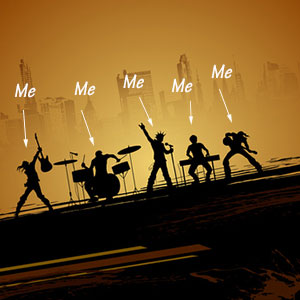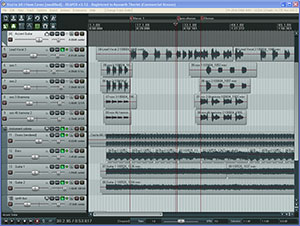 Do you play several instruments? Can you sing harmony? Would you like to record yourself doing all those things at the same time? Are you broke?
Do you play several instruments? Can you sing harmony? Would you like to record yourself doing all those things at the same time? Are you broke?If you answered yes to all the above, there may be some very good news for you. I know a way you can record yourself doing one thing, then record yourself doing something else along with that first thing. This used to be called “sound-on-sound” recording. More often these days, it is called “over-dubbing.” All you need to over-dub several tracks of audio is a computer with a sound card, and a microphone to plug into the computer. Even one of those cheapo $5.00 plastic PC mics will get you started. Would you not agree that a LOT of folks have that stuff already? Or they could have it after a quick trip to the local office-supply store (for the mic). Once you have all that stuff, all you need to do is download an open-source audio program called Audacity from the internet, and install it on your computer. You now have a home recording studio!
So how do you do the one-person-band thing? Let’s imagine you play guitar and sing. First, you would plug the mic into the pink jack of the sound card. Then open Audacity. Click the button in the tool bar that looks like a big red dot, which means “record.” Your studio will now be recording. Play the guitar part to a song you know…JUST the guitar part; no singing just yet.
Once you finish the guitar part, you’ll need to stop recording (click the “stop” button, which looks like a big square in the toolbar), and make one change to your studio set-up. Turn the speakers off and make sure you plug some headphones/earphones into the sound card’s green jack. Did I mention you’d also need some sort of earphones? Do you have an mp3 player…or do you know someone who does? Just use the ear-buds or headphones you use for those.
Next, “rewind” Audacity back to the beginning by clicking the button that has two backwards purple arrow-triangles on it. Then click the record button again and sing along with the guitar. You now have a vocal track and a guitar track. If you want to add harmonies, you just repeat the above step as many times as you have harmonies in the song. You could also add percussion, other instruments, etc. and voila! You have a recording of yourself as an entire band.
You’ll want to use Audacity’s editing tools now to make sure the tracks are synchronized, which you can do by zooming in and dragging the tracks left or right until they sound right. You will probably also want to mix the volumes and pan some tracks left and right, all of which you can do with the tools that come with Audacity. Export a stereo file from Audacity, and you have just recorded a song on a $5.00 budget.
The audio won’t be super high-end, but it CAN be surprisingly good. If you want to hear an example of something like this, check out the Home Brew Audio website for a demo video and several tutorials on how to get the most out of the lowest budget.
 Multitrack recording is one of the coolest things EVER. In the 80s when I first started recording music (okay, you can stop counting now…;)), multi track recording was not something a 15-year-old could afford to do without a major record deal or a family member who owned a studio. But in 2010, anyone can do it, and as long as you have a computer with an internet connection, it doesn’t have to cost you anything at all. Man, I love this century.
Multitrack recording is one of the coolest things EVER. In the 80s when I first started recording music (okay, you can stop counting now…;)), multi track recording was not something a 15-year-old could afford to do without a major record deal or a family member who owned a studio. But in 2010, anyone can do it, and as long as you have a computer with an internet connection, it doesn’t have to cost you anything at all. Man, I love this century. When creating a voiceover recording (or voice over, or voice-over…nobody seems to know for sure;)), the final product is usually nothing but the voice…all by itself…with nothing else to hide flaws. Yes, sometimes voice overs are accompanied by background music, such as when narrating short videos, or in podcast intros and “outros.” But for the most part a voiceover recording is just that, the voice.
When creating a voiceover recording (or voice over, or voice-over…nobody seems to know for sure;)), the final product is usually nothing but the voice…all by itself…with nothing else to hide flaws. Yes, sometimes voice overs are accompanied by background music, such as when narrating short videos, or in podcast intros and “outros.” But for the most part a voiceover recording is just that, the voice.

